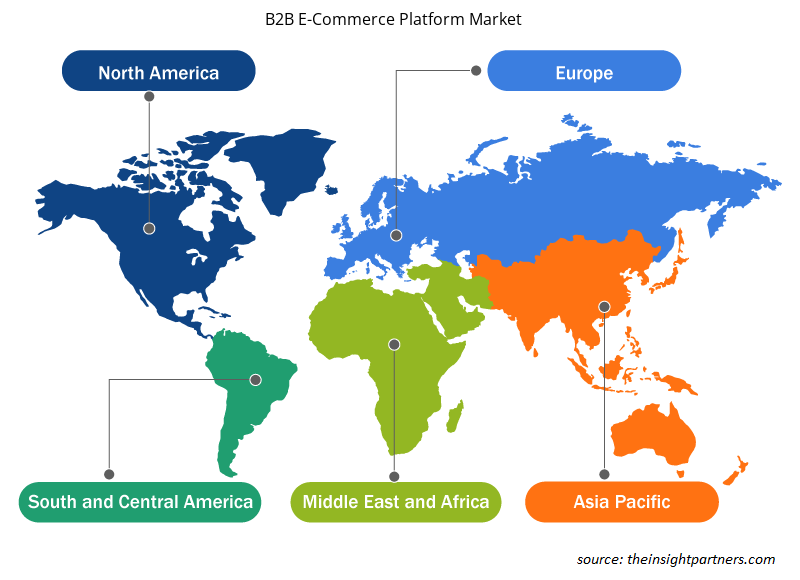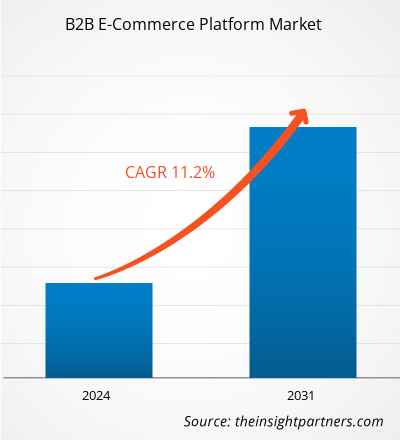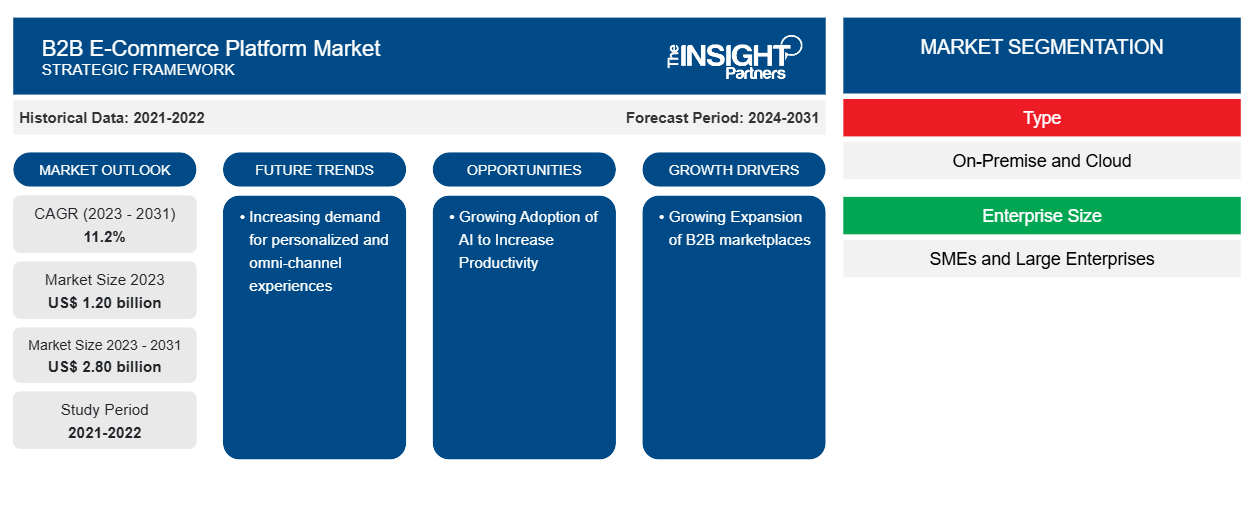Der Markt für B2B-E-Commerce-Plattformen soll von 1,20 Milliarden US-Dollar im Jahr 2023 auf 2,80 Milliarden US-Dollar im Jahr 2031 anwachsen. Der Markt soll zwischen 2023 und 2031 eine durchschnittliche jährliche Wachstumsrate (CAGR) von 11,2 % verzeichnen. Die steigende Nachfrage nach personalisierten und Omnichannel-Erlebnissen dürfte ein wichtiger Trend auf dem Markt für B2B-E-Commerce-Plattformen bleiben.
Marktanalyse für B2B-E-Commerce-Plattformen
Viele Unternehmen nutzen digitale Technologien, um das Kundenerlebnis zu verbessern, die Effizienz zu steigern und Prozesse zu automatisieren. Online-Geschäfte werden für Unternehmen durch die zunehmende Verbreitung von Smartphones und die fortschreitende Entwicklung von Hochgeschwindigkeits-Internetnetzwerken immer einfacher. Infolgedessen stehen mehr B2B-E-Commerce-Plattformen zur Verfügung, die Unternehmen eine einfache und effektive Möglichkeit bieten, mit Kunden und Partnern zu kommunizieren. Gleichzeitig ermöglicht die fortschreitende Globalisierung Unternehmen, B2B- E-Commerce mit Kunden und Lieferanten auf der ganzen Welt zu betreiben und so den internationalen Handel anzukurbeln.
Marktübersicht für B2B-E-Commerce-Plattformen
B2B-Handel (Business-to-Business) ist der Austausch von Waren, Dienstleistungen oder Informationen zwischen Unternehmen und nicht zwischen Unternehmen und Verbrauchern (B2C). Eine B2B-Transaktion findet zwischen zwei Unternehmen statt, beispielsweise zwischen einem Internethändler und einem Großhändler. Die Ausbreitung der Pandemie war einer der Hauptfaktoren, die das Wachstum des Marktes in den letzten Jahren vorangetrieben haben, da die meisten Unternehmen verschiedene Einschränkungen einhalten müssen. Darüber hinaus fördert auch die zunehmende Zahl von Millennials, die in den B2B-Bereich eintreten, das Wachstum des Marktes für B2B-E-Commerce-Plattformen.
Passen Sie diesen Bericht Ihren Anforderungen an
Sie erhalten kostenlose Anpassungen an jedem Bericht, einschließlich Teilen dieses Berichts oder einer Analyse auf Länderebene, eines Excel-Datenpakets sowie tolle Angebote und Rabatte für Start-ups und Universitäten.
-
Holen Sie sich die wichtigsten Markttrends aus diesem Bericht.Dieses KOSTENLOSE Beispiel umfasst eine Datenanalyse von Markttrends bis hin zu Schätzungen und Prognosen.
Treiber und Chancen auf dem B2B-E-Commerce-Plattformmarkt
Wachsende Expansion von B2B-Marktplätzen
B2B-Anbieter nutzen E-Commerce-Plattformen von Drittanbietern, um ihre Reichweite zu vergrößern, die Konkurrenz einzuschätzen und Käufern, die Marktplätze wie Amazon Business und Alibaba.com für ihre Einkäufe nutzen, Komfort zu bieten. B2B-Marktplätze bieten Käufern Ressourcen wie Preisvergleiche, Kundenbewertungen und Produktrezensionen. Aus diesem Grund bestellen oder bezahlen laut Google mehr als 80 % der B2B-Käufer lieber über digitale Handelskanäle. Daher treibt die zunehmende Expansion von B2B-Marktplätzen das Wachstum des Marktes für B2B-E-Commerce-Plattformen voran.Alibaba.com to make purchases. B2B marketplaces provide buyers with resources such as comparative shopping, customer ratings, and product reviews. For this reason, according to Google, more than 80% of B2B buyers prefer to order or make payments through digital commerce channels. Hence, the growing expansion of B2B marketplaces is fueling the growth of the B2B E-Commerce Platform Market.
Zunehmender Einsatz von KI zur Steigerung der Produktivität
Laut Salesforce, Inc. haben 32 % der B2B-Unternehmen KI vollständig integriert, während sich fast die Hälfte (45 %) noch in der Experimentierphase befindet. Die Unternehmen haben bereits erhebliche Zuwächse bei der Mitarbeiterproduktivität und der betrieblichen Effizienz festgestellt. Darüber hinaus kann KI bisher problematische Bereiche der digitalen B2B-Transformation erheblich verbessern. KI hat das Potenzial, den für diese Aufgaben erforderlichen manuellen Arbeitsaufwand erheblich zu reduzieren. Mit generativer KI können Unternehmen jetzt einen größeren Teil ihres Inventars digital darstellen – und viele werden in der Lage sein, noch komplexere Produktmaterialien wie visuelle Kauferlebnisse anzubieten. Daher wird erwartet, dass die zunehmende Einführung von KI im Prognosezeitraum eine Chance für das Wachstum des Marktes für B2B-E-Commerce-Plattformen schafft.forecasted period.
B2B E-Commerce-Plattform Marktbericht Segmentierungsanalyse
Wichtige Segmente, die zur Ableitung der Marktanalyse für B2B-E-Commerce-Plattformen beigetragen haben, sind Typ, Unternehmensgröße und Endbenutzerbranche.
- Basierend auf dem Typ ist der Markt für B2B-E-Commerce-Plattformen in On-Premise und Cloud segmentiert. Das On-Premise-Segment hatte im Jahr 2023 einen größeren Marktanteil.
- Basierend auf der Unternehmensgröße ist der Markt in KMU und Großunternehmen segmentiert. Das Segment der Großunternehmen hatte im Jahr 2023 einen größeren Marktanteil.
- Basierend auf der Endverbraucherbranche ist der Markt segmentiert in Automobil , Elektro- und Elektronikindustrie, allgemeine Industrie und Sonstige. Das Automobilsegment dürfte im Prognosezeitraum ein deutliches Wachstum verzeichnen.
B2B E-Commerce-Plattform Marktanteilsanalyse nach Geografie
Der geografische Umfang des Berichts zum Markt für B2B-E-Commerce-Plattformen ist hauptsächlich in fünf Regionen unterteilt:Nordamerika, Asien-Pazifik, Europa, Naher Osten und Afrika sowie Südamerika/Süd- und Mittelamerika.
Im asiatisch-pazifischen Raum wird ein deutliches Wachstum des Marktes für B2B-E-Commerce-Plattformen erwartet. Der Markt in dieser Region ist in Australien, China, Indien, Japan, Südkorea und den Rest des asiatisch-pazifischen Raums unterteilt. Die zunehmende Industrialisierung und Urbanisierung der Region, insbesondere in China, Japan und Indien, werden das Marktwachstum voraussichtlich ankurbeln. Laut der International Air Transport Association (IATA) führt der asiatisch-pazifische Raum das Wachstum des E-Commerce-Marktes weltweit an, wobei China einen erheblichen Prozentsatz des Wachstums ausmacht. Laut der International Trade Administration ist der chinesische E-Commerce-Markt der größte der Welt und generiert fast 50 % der weltweiten Transaktionen. Darüber hinaus wird der indische E-Commerce-Markt laut der India Brand Equity Foundation (IBEF) bis 2025 voraussichtlich 188 Milliarden US-Dollar erreichen. Der wachsende E-Commerce-Sektor in der Region treibt also das Wachstum des Marktes für B2B-E-Commerce-Plattformen voran.APAC. The region's expanding industrialization and urbanization, particularly in China, Japan, and India, are likely to boost market expansion. Also, According to the International Air Transport Association (IATA), APAC leads the growth of the e-commerce market globally, with China accounting for a significant percentage of the growth. As per the International Trade Administration, the e-commerce market of China is the largest in the world and generates almost 50% of the world’s transactions. Furthermore, according to the India Brand Equity Foundation (IBEF), the e-commerce market in India is expected to reach US$ 188 billion by 2025. Thus, the growing e-commerce sector in the region is fueling the growth of the B2B e-commerce platform market.
Regionale Einblicke in den Markt für B2B-E-Commerce-Plattformen
Die regionalen Trends und Faktoren, die den Markt für B2B-E-Commerce-Plattformen im Prognosezeitraum beeinflussen, wurden von den Analysten von Insight Partners ausführlich erläutert. In diesem Abschnitt werden auch die Marktsegmente und die Geografie von B2B-E-Commerce-Plattformen in Nordamerika, Europa, im asiatisch-pazifischen Raum, im Nahen Osten und Afrika sowie in Süd- und Mittelamerika erörtert.

- Erhalten Sie regionale Daten zum B2B-E-Commerce-Plattformmarkt
Umfang des Marktberichts zur B2B-E-Commerce-Plattform
| Berichtsattribut | Details |
|---|---|
| Marktgröße im Jahr 2023 | 1,20 Milliarden US-Dollar |
| Marktgröße bis 2031 | 2,80 Milliarden US-Dollar |
| Globale CAGR (2023 - 2031) | 11,2 % |
| Historische Daten | 2021-2022 |
| Prognosezeitraum | 2024–2031 |
| Abgedeckte Segmente |
Nach Typ
|
| Abgedeckte Regionen und Länder |
Nordamerika
|
| Marktführer und wichtige Unternehmensprofile |
|
Marktteilnehmerdichte: Der Einfluss auf die Geschäftsdynamik
Der Markt für B2B-E-Commerce-Plattformen wächst rasant. Dies wird durch die steigende Nachfrage der Endnutzer aufgrund von Faktoren wie sich entwickelnden Verbraucherpräferenzen, technologischen Fortschritten und einem größeren Bewusstsein für die Vorteile des Produkts vorangetrieben. Mit der steigenden Nachfrage erweitern Unternehmen ihr Angebot, entwickeln Innovationen, um die Bedürfnisse der Verbraucher zu erfüllen, und nutzen neue Trends, was das Marktwachstum weiter ankurbelt.
Die Marktteilnehmerdichte bezieht sich auf die Verteilung von Firmen oder Unternehmen, die in einem bestimmten Markt oder einer bestimmten Branche tätig sind. Sie gibt an, wie viele Wettbewerber (Marktteilnehmer) in einem bestimmten Marktraum im Verhältnis zu seiner Größe oder seinem gesamten Marktwert präsent sind.
Die wichtigsten Unternehmen auf dem Markt für B2B-E-Commerce-Plattformen sind:
- Apttus Corporation
- BigCommerce Pty. Ltd.
- Alibaba
- Kibo Handel
- Magneto IT Solutions Pvt. Ltd
- On Demand Solutions Ltd.
Haftungsausschluss : Die oben aufgeführten Unternehmen sind nicht in einer bestimmten Reihenfolge aufgeführt.

- Erhalten Sie einen Überblick über die wichtigsten Akteure auf dem B2B-E-Commerce-Plattformmarkt
Neuigkeiten und aktuelle Entwicklungen zum B2B-E-Commerce-Plattformmarkt
Der Markt für B2B-E-Commerce-Plattformen wird durch die Erfassung qualitativer und quantitativer Daten nach Primär- und Sekundärforschung bewertet, die wichtige Unternehmensveröffentlichungen, Verbandsdaten und Datenbanken umfasst. Im Folgenden finden Sie eine Liste der Entwicklungen auf dem Markt:
- Schaeffler India Limited, eine Tochtergesellschaft der Schaeffler AG, hat einen Aktienkaufvertrag zum Erwerb von 100 Prozent der Anteile an KRSV Innovative Auto Solutions Private Limited (im Folgenden „KRSV“) unterzeichnet. KRSV hat seinen Hauptsitz in Bengaluru und bietet über seine schnell wachsende B2B-E-Commerce-Plattform Koovers Reparaturlösungen für indische Aftermarket-Werkstätten an. Koovers ist eine ideale Ergänzung der Aktivitäten von Schaeffler Automotive Aftermarket in Indien. (Quelle: Schaeffler, Pressemitteilung, 2023)
- BigCommerce, eine führende Open SaaS-E-Commerce-Plattform für schnell wachsende und etablierte B2C- und B2B-Marken, gab die Übernahme von BundleB2B bekannt, einem langjährigen BigCommerce-Technologiepartner, der BigCommerce-Händlern B2B-Funktionalität der nächsten Generation bietet. (Quelle: Intertek, Pressemitteilung, 2021)
Marktbericht zu B2B-E-Commerce-Plattformen: Abdeckung und Ergebnisse
Der Bericht „Marktgröße und Prognose für B2B-E-Commerce-Plattformen (2021–2031)“ bietet eine detaillierte Analyse des Marktes, die die folgenden Bereiche abdeckt:
- Marktgröße und Prognose auf globaler, regionaler und Länderebene für alle wichtigen Marktsegmente, die im Rahmen des Projekts abgedeckt sind
- Marktdynamik wie Treiber, Beschränkungen und wichtige Chancen
- Wichtige Zukunftstrends
- Detaillierte PEST/Porters Five Forces- und SWOT-Analyse
- Globale und regionale Marktanalyse mit wichtigen Markttrends, wichtigen Akteuren, Vorschriften und aktuellen Marktentwicklungen
- Branchenlandschaft und Wettbewerbsanalyse, einschließlich Marktkonzentration, Heatmap-Analyse, prominenten Akteuren und aktuellen Entwicklungen
- Detaillierte Firmenprofile
- Historische Analyse (2 Jahre), Basisjahr, Prognose (7 Jahre) mit CAGR
- PEST- und SWOT-Analyse
- Marktgröße Wert/Volumen – Global, Regional, Land
- Branchen- und Wettbewerbslandschaft
- Excel-Datensatz
Aktuelle Berichte
Erfahrungsberichte
Grund zum Kauf
- Fundierte Entscheidungsfindung
- Marktdynamik verstehen
- Wettbewerbsanalyse
- Kundeneinblicke
- Marktprognosen
- Risikominimierung
- Strategische Planung
- Investitionsbegründung
- Identifizierung neuer Märkte
- Verbesserung von Marketingstrategien
- Steigerung der Betriebseffizienz
- Anpassung an regulatorische Trends























 Kostenlose Probe anfordern für - Markt für B2B-E-Commerce-Plattformen
Kostenlose Probe anfordern für - Markt für B2B-E-Commerce-Plattformen